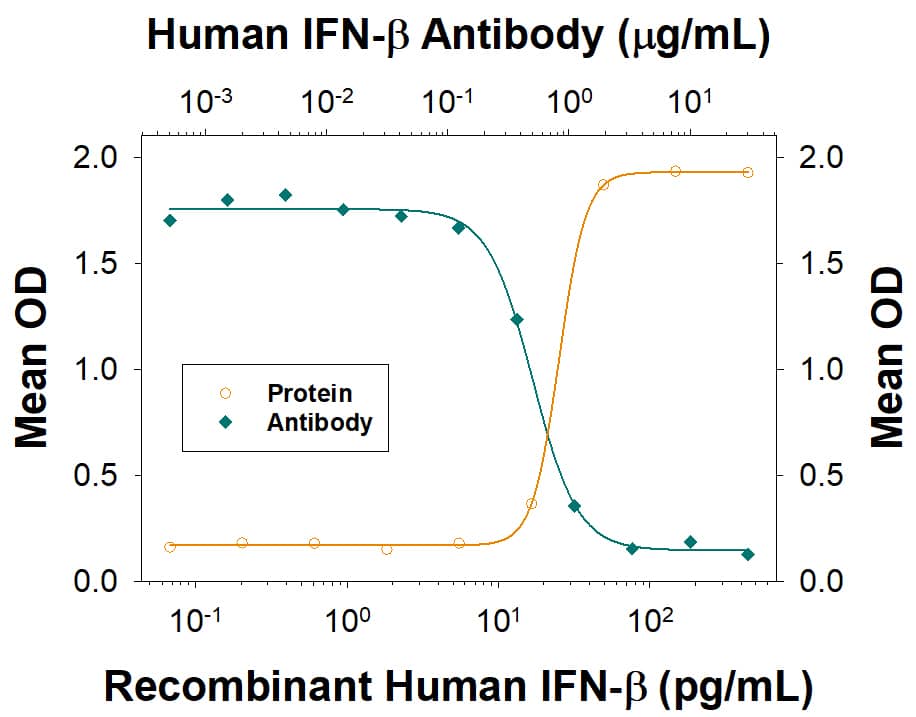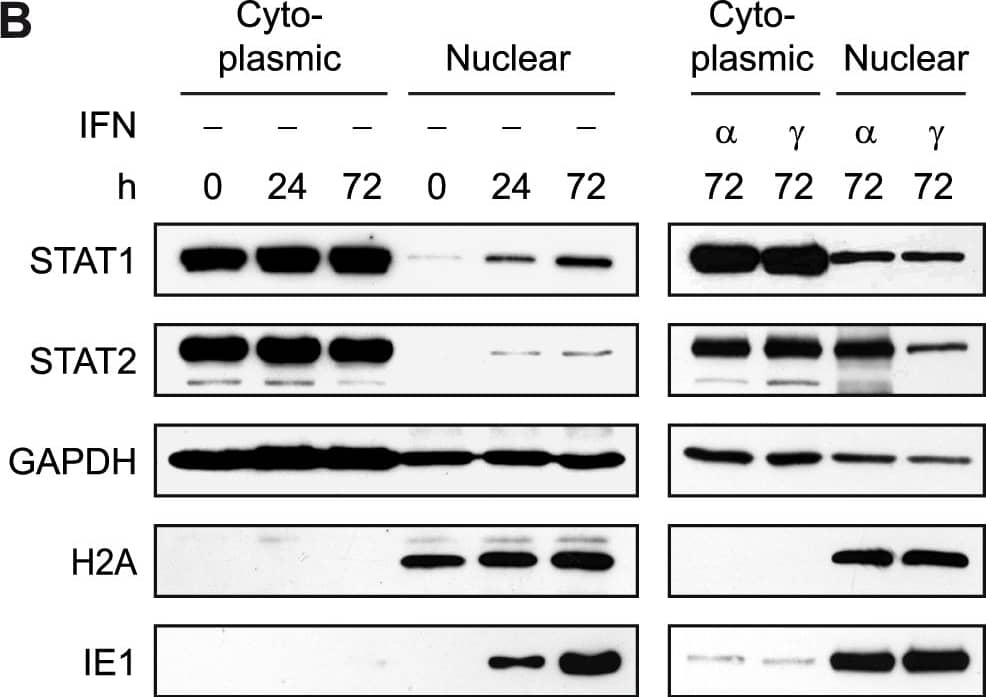Human IFN-beta Antibody Summary
Applications
Please Note: Optimal dilutions should be determined by each laboratory for each application. General Protocols are available in the Technical Information section on our website.
Scientific Data
 View Larger
View Larger
IFN‑ beta Inhibition of EMCV-induced Cytopathy and Neutralization by Human IFN-beta Antibody. Recombinant Human IFN-beta (8499-IF) reduces the Encephalomyocarditis Virus (EMCV)-induced cytopathy in the HeLa human cervical epithelial carcinoma cell line in a dose-dependent manner (orange line), as measured by crystal violet staining. Inhibition of EMCV activity elicited by Recombinant Human IFN-beta (50 pg/mL) is neutralized (green line) by increasing concentrations of Goat Anti-Human IFN-beta Antigen Affinity-purified Polyclonal Antibody (Catalog # AF814). The ND50 is typically 0.100 - 1.00 µg/mL.
 View Larger
View Larger
Detection of IFN-beta by Western Blot IE1 expression leads to nuclear accumulation of STAT1.A) TetR and TetR-IE1 cells were treated with doxycycline for 72 h. Where indicated, TetR cells were incubated in the presence of IFN-gamma or IFN-alpha for 1 h before samples were fixed with paraformaldehyde and examined by indirect immunofluorescence coupled to confocal microscopy. Samples were simultaneously reacted with rabbit polyclonal antibodies against STAT1 (left) or STAT2 (right) and a mouse monoclonal antibody against IE1, followed by incubation with a rabbit-specific Alexa Fluor 546 conjugate and a mouse-specific Alexa Fluor 633 conjugate. TetRnlsEGFP (TetR) fluorescence is shown to visualize nuclei. Additionally, merge images of STAT, IE1, and TetR signals are presented. Scale bar, 10 µm. B) TetR-IE1 cells were treated with doxycycline for 0 h, 24 h, or 72 h. Cytoplasmic and nuclear extracts were prepared and subjected to immunoblotting with anti-STAT1, anti-STAT2, anti-GAPDH, anti-H2A, and anti-IE1 antibodies. For the right panel, TetR-IE1 cells were treated with IFN-alpha or IFN-gamma for 1 h before fractionation. Image collected and cropped by CiteAb from the following open publication (https://pubmed.ncbi.nlm.nih.gov/21533215), licensed under a CC-BY license. Not internally tested by R&D Systems.
Preparation and Storage
- 12 months from date of receipt, -20 to -70 °C as supplied.
- 1 month, 2 to 8 °C under sterile conditions after reconstitution.
- 6 months, -20 to -70 °C under sterile conditions after reconstitution.
Background: IFN-beta
IFN-beta (interferon beta; also fibroblast IFN) is a secreted, monomeric 23-24 kDa member of the alpha/beta interferon family of molecules. It can be produced by almost all cell types in response to bacterial DNA or viral double-stranded RNA and is abundantly secreted by circulating plasmacytoid DCs. IFN-beta drives monocytic transformation into DCs, and it appears to stimulate a B cell switch from from IgM to IgG secretion. Mature human IFN-beta is 166 amino acids (aa) in length (aa 22-187) and contains one phosphorylation site at Ser140. There is one potential alternative start site at Met22. Full-length human IFN-beta (aa 22-187) shares 47% aa identity with mouse IFN-beta.
Product Datasheets
Product Specific Notices
Sold under license from Pestka Biomedical Laboratories, Inc. d/b/a PBL Interferon Source. For research use only. Not for resale. Not for diagnostic, therapeutic or clinical purposes.Citations for Human IFN-beta Antibody
R&D Systems personnel manually curate a database that contains references using R&D Systems products. The data collected includes not only links to publications in PubMed, but also provides information about sample types, species, and experimental conditions.
11
Citations: Showing 1 - 10
Filter your results:
Filter by:
-
New World hantaviruses activate IFNlambda production in type I IFN-deficient vero E6 cells
Authors: Joseph Prescott, Pamela Hall, Mariana Acuna-Retamar, Chunyan Ye, Marc G. Wathelet, Hideki Ebihara et al.
PLoS ONE
-
Sangassou Virus, the First Hantavirus Isolate from Africa, Displays Genetic and Functional Properties Distinct from Those of Other Murinae-Associated Hantaviruses
Authors: Boris Klempa, Peter T. Witkowski, Elena Popugaeva, Brita Auste, Lamine Koivogui, Elisabeth Fichet-Calvet et al.
Journal of Virology
-
Data supporting the roles of BAP1, STING, and IFN-beta in ISGF3 activation in ccRCC
Authors: LE Langbein, E Sementino, Z Zhong, W Jiang, L Li, JR Testa, H Yang
Data in Brief, 2022-11-11;45(0):108743.
Species: Human
Sample Types: Whole Cells
Applications: Neutralization -
Live imaging of neolymphangiogenesis identifies acute antimetastatic roles of dsRNA mimics
Authors: D Olmeda, D Cerezo-Wal, C Mucientes, TG Calvo, E Cañón, D Alonso-Cur, N Ibarz, J Muñoz, JL Rodriguez-, P Ortiz-Rome, S Ortega, MS Soengas
Embo Molecular Medicine, 2021-11-11;0(0):e12924.
Species: Human
Sample Types: Whole Cells
Applications: Neutralization -
Dobrava-Belgrade hantavirus from Germany shows receptor usage and innate immunity induction consistent with the pathogenicity of the virus in humans.
Authors: Popugaeva E, Witkowski PT, Schlegel M, Ulrich RG, Auste B, Rang A, Kruger DH, Klempa B
PLoS ONE, 2012-04-24;7(4):e35587.
Species: Human
Sample Types: Whole Cells
Applications: Neutralization -
Human cytomegalovirus IE1 protein elicits a type II interferon-like host cell response that depends on activated STAT1 but not interferon-gamma.
Authors: Knoblach T, Grandel B, Seiler J, Nevels M, Paulus C
PLoS Pathog., 2011-04-14;7(4):e1002016.
Species: Human
Sample Types: Whole Cells
Applications: Neutralization -
The LIM-homeodomain transcription factor LMX1B regulates expression of NF-kappa B target genes.
Authors: Rascle A, Neumann T, Raschta AS, Neumann A, Heining E, Kastner J, Witzgall R
Exp. Cell Res., 2008-10-28;315(1):76-96.
Species: Human
Sample Types: Whole Cells
Applications: Neutralization -
TLR3 can directly trigger apoptosis in human cancer cells.
Authors: Salaun B, Coste I, Rissoan MC, Lebecque SJ, Renno T
J. Immunol., 2006-04-15;176(8):4894-901.
Species: Human
Sample Types: Whole Cells
Applications: Neutralization -
Inhibition of human immunodeficiency virus type 1 replication by Z-100, an immunomodulator extracted from human-type tubercle bacilli, in macrophages.
Authors: Emori Y, Ikeda T, Ohashi T, Masuda T, Kurimoto T, Takei M, Kannagi M
J. Gen. Virol., 2004-09-01;85(0):2603-13.
Species: Human
Sample Types: Whole Cells
Applications: Neutralization -
PRC2-mediated epigenetic suppression of type I IFN-STAT2 signaling impairs antitumor immunity in luminal breast cancer
Authors: J Hong, JH Lee, Z Zhang, Y Wu, M Yang, Y Liao, R de la Rosa, J Scheirer, D Pechacek, N Zhang, Z Xu, T Curiel, X Tan, TH Huang, K Xu
Cancer Research, 2022-12-16;0(0):.
-
Single-cell analysis of early antiviral gene expression reveals a determinant of stochastic IFNB1 expression
Authors: Sultan Doğanay, Maurice Youzong Lee, Alina Baum, Jessie Peh, Sun-Young Hwang, Joo-Yeon Yoo et al.
Integrative Biology
FAQs
No product specific FAQs exist for this product, however you may
View all Antibody FAQsReviews for Human IFN-beta Antibody
There are currently no reviews for this product. Be the first to review Human IFN-beta Antibody and earn rewards!
Have you used Human IFN-beta Antibody?
Submit a review and receive an Amazon gift card.
$25/€18/£15/$25CAN/¥75 Yuan/¥2500 Yen for a review with an image
$10/€7/£6/$10 CAD/¥70 Yuan/¥1110 Yen for a review without an image




